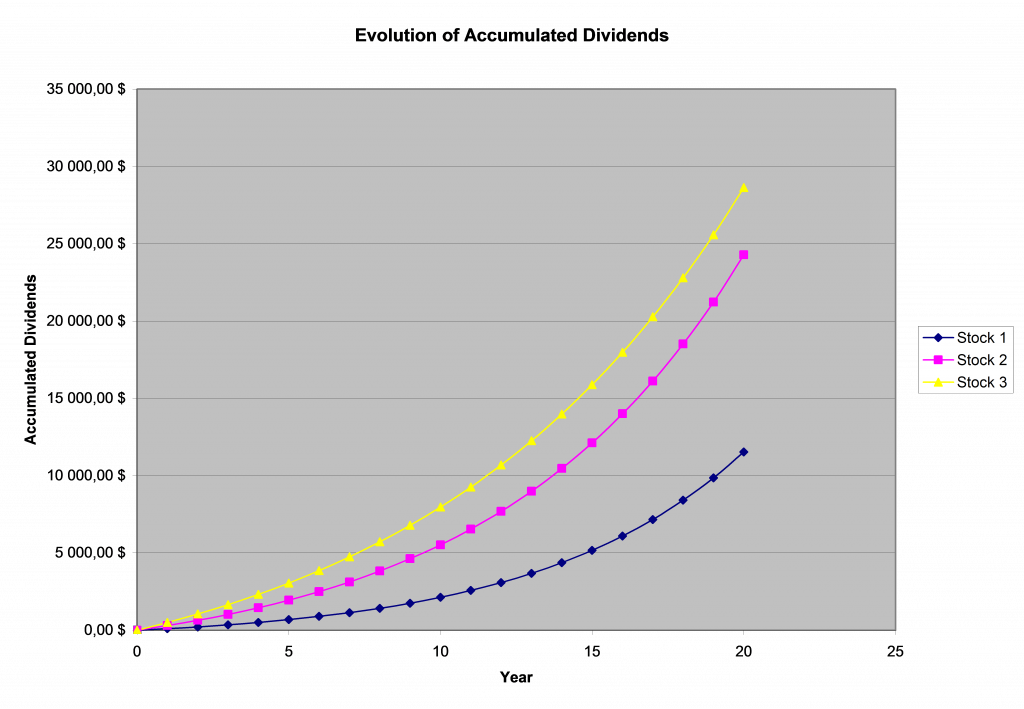This is a guest post written by a new dividend investor blogger; Frank @ Dividend Engineering [1]. You guessed it, as many DYI investors he is an engineer ;-).
To paraphrase John William Burr, one of the founding fathers of stock valuation, a stock is worth what you can get out of it. This simple principle applies completely to dividend investing. In fact, it is probably the basic principle of dividend investing. We, as dividend investors, buy dividend stocks to receive regular and growing payments. So, the more we get out of a stock, the better.
Keeping the foregoing principle in mind, it generally follows that we would prefer getting the most out of a stock as soon as possible. Indeed, all else being equal (I know, this is rarely the case), I prefer to receive more money now than later. And there are several reasons for that.
First, if we forgo current payment for future growth, the future growth must be interesting enough for us to wait. However, the longer we project dividend growth into the future, the less reliable our projections are. Projecting dividend growth with some measure of accuracy 5 years in the future in already difficult, projecting dividend growth 10 years or even 20 years in future is downright impossible.
Second, the higher the dividend growth, the less likely the growth will be sustainable over the long term. Understandably, a company can grow its dividend 15% per year for a couple of years. However, it would be difficult for that company to grow its dividend 15% per year for 10, 20 years. I know that some companies manage to do it but finding such companies before they do it is harder than it seems.
Third, the faster we receive the most out of a stock, in other words, the higher the yield, the faster we can reinvest our dividends into additional shares of dividend stocks. In turn, these additional shares will pay dividends which we can again reinvest into further additional shares. And so on and so forth. Understandably, the high yield must be sustainable.
So, in order to get the most out of a stock, is higher yield with lower growth better than lower yield with higher growth?
As an engineer, I like to play with numbers. So, to answer my question, I have tested three different stocks with different yields and different growths.
Stock 1 has a current yield of 1% and a dividend growth of 15%. Stock 2 has a current yield of 3% and a dividend growth of 10%. Finally, stock 3 has a current yield of 5% and a dividend growth of 5%.
In the following analysis, I have assumed an initial investment of 10 000$ in each stock. I have also assumed that the dividends are reinvested in the same stock and that the price of the stock grows at the same rate as the dividend such that the current yield stays the same. I have also assumed that the dividends are reinvested once a year. I know, except for the initial investments, the above assumptions are only what they are, assumptions. However, I think they fairly correspond to the reality, at least enough to answer my question.
The graph below illustrates the accumulated dividends of each of the three stocks over a period of 20 years.
As can be seen from the graph, over the 20 year period, stock 3, the stock with high yield and low growth, always returns more money than either stock 1 or stock 2. Looking at the trend though, stock 2 seems to be catching up. However, stock 1, the stock with low yield and high growth, is significantly far behind both stock 1 and stock 2.
In more concrete terms, after 20 years, stock 3, with its high yield and low growth, will have returned shy of 29 000$ in dividends. Following close behind, stock 2 will have returned almost 25 000$ in dividends after 20 years. However, far behind, stock 1, with its low yield and high growth, will have returned only slightly less than 12 000$.
Hence, from the graph, it seems pretty clear that stocks having higher yield, even with lower growth, will return much more money to their happy shareholders than stocks having lower yield, even with high growth. It seems to be caused by the fact the high yielding stocks allow you to compound more money, even if at lower rate. In any case, I don’t know for you, but I prefer to have 29 000$ in my pockets than only 12 000$.
Finally, the graph above assumes constant growth. However, as mentioned at the beginning, it is harder for a company to constantly raise its dividend at 15% than at 5%, the more so over long periods of time. Hence, if, for instance, stock 1 cannot sustain its annual dividend growth of 15% and must lower it at 10% 10 years down the road, then the above results will be even worse for stock 1.
So, if the high yield is sustainable and properly covered by earnings and free cash flow, I think it is better to invest in higher yield stocks, even if the growth is on the low side, than to invest in low yield stocks having higher though probably unsustainable growth.
As the say goes: “A bird in the hand is worth two in the bush.” I think it applies to dividend investing.
Google+ [3]
